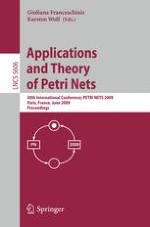This book constitutes the refereed proceedings of the 30th International Conference on Applications and Theory of Petri Nets and Other Models of Concurrency, PETRI NETS 2009, held in Paris, France, in June 2009. The 19 revised papers classified as theory papers (13), application papers (1), and tool papers (5) were carefully reviewed and selected from 46 submissions. All current issues on research and development in the area of Petri nets and related models of concurrent systems are addressed, novel tools as well as substantial enhancements to existing tools are presented.
